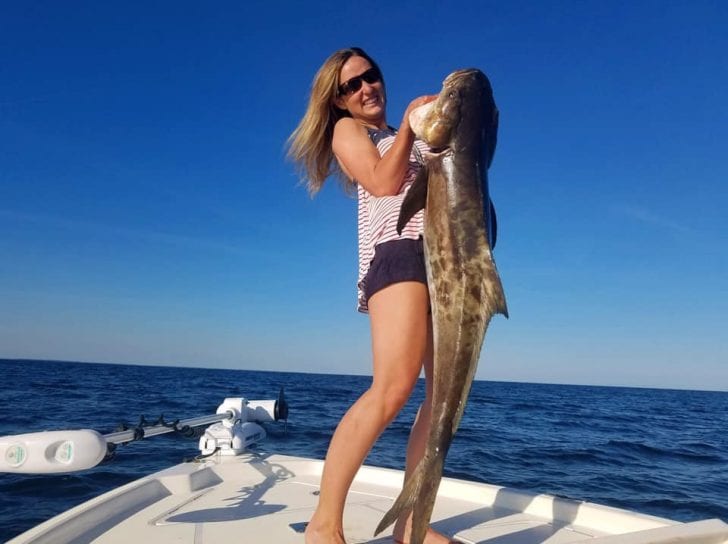COBIA FEVER
It’s May in the Big Bend region, and that means but one thing, it’s “Cobia Season”. As the water pushes to the low 70’s, the spring migration of these pelagic fish, occurs off the coast in this area, from the shallows, to well off shore, making them accessible to a wide variety of anglers.
The methods of catching them are many, as they range from the bottom, to the top of the water column. Being a very curious fish, it sometimes gets them into trouble, as they will surface to investigate a boat, and that is how most cobia are taken.
The local method of chasing cobia is to chum on the surface, with a few live baits, freelined out the back of the boat, while fishing for other species, resulting in a fish or two taken, and considered a good day.
Being from Virginia where cobia are king, and chased on purpose, I am going to tell you how to catch more–a lot more.
Cobia are bottom fish, as you can tell by the flat body shape, like a catfish. They spend very little time off the bottom, except when they are catching southern wind-blown waves, north to their spawning grounds. Being a bottom fish, it only makes sense to target them “on the bottom”.
Take a five-gallon bucket with a lid, and drill ½ inch holes all over it, including the top, so it will sink faster. Place a weight in the bottom, and put a block of chum in, along with some old shrimp if you have them, or crushed up blue crab. Hang midship, until it hits the bottom.
Deploy two rods with a 3-inch 80 lb. test leader and 8/0 J hook to your 65 lb. running line via a 200 lb. barrel swivel, and a sliding sinker capable of keeping it on the bottom.
These two rods will be put in the bow and stern rod holders, so the bait will be on the two sides of the chum pot, and they will catch the majority of your fish.
You want to throw your third rod out the back of the boat as a free-swimming bait, consisting of pinfish, etc.
Let’s talk bait for a second. After examining the contents of over 100 cobias, I have found that they, in this area like a 6 to 10-inch hard head catfish.
Catch the cats the day before, and clip the three stickers off at the body so they can be handled, and the cobia will like them better.
While waiting for a bite, do not allow your buddies to fish for other species, as it always ends up in disaster. If you are going cobia fishing, then go cobia fishing.
The line out the rear of the boat will go off with a zing most of the time, and you know the drill on that. The lines beside the pot are another story, as the cobia in most cases will just pick up the bait, and stay in the area of the chum, so you have to watch these carefully. When the cobia moves the bait, ease up to the rod, and take it out of the holder, winding down until you feel his weight. At this point, set the hook, and have your mates wind in the other lines, starting with the other bottom line. Then pull up the pot and wind in the line out the back.
Fight the fish like any other large fish, and when he tires, either gaff him, or use a large sturdy landing net, to bring him straight into the cooler. These fish can, and have, broken bones and tackle.
Before releasing, look closely on the left side, under the dorsal fin before releasing under-slot (Less then 33 inches to the fork.) fish, or those you don’t want to keep, as they may be tagged. Take a picture of the tag, so you can magnify it, and see the tag and phone number of the institute that the info is to go to.
We tag cobia for the Gulf Research Lab, and would appreciate the reporting of the measured catch and approximant location. You can report it, and receive a certificate, stating where it was first tagged, and how big it was at that point.
I hope you take away some useful information from this article, and follow it to the tee, and if you do, you will improve your catch numbers drastically.
As far as where to fish for cobia, find a wreck or reef, known to hold fish, and chum up current to pull them out of the structure. Go over your charts to find a lump or drop-off in 15 to 30 feet of water, and chum on top of the lump or ledge so the chum flows down the hill, so to speak. Time your outing, so the tide is not running hard, and is going in the same direction, as the way you want your chum to go.
Cobia numbers are at this point going down for unexplained reasons, thus the reason for tagging and gathering more information about them. Take only what you need to eat, and release the rest for another anglers’ exciting experience, and it is an exciting experience!
Denny Seabright can be found writing weekly fishing reports on their Face Book Page BackCountryChronicles or find them @Redfishhunt

